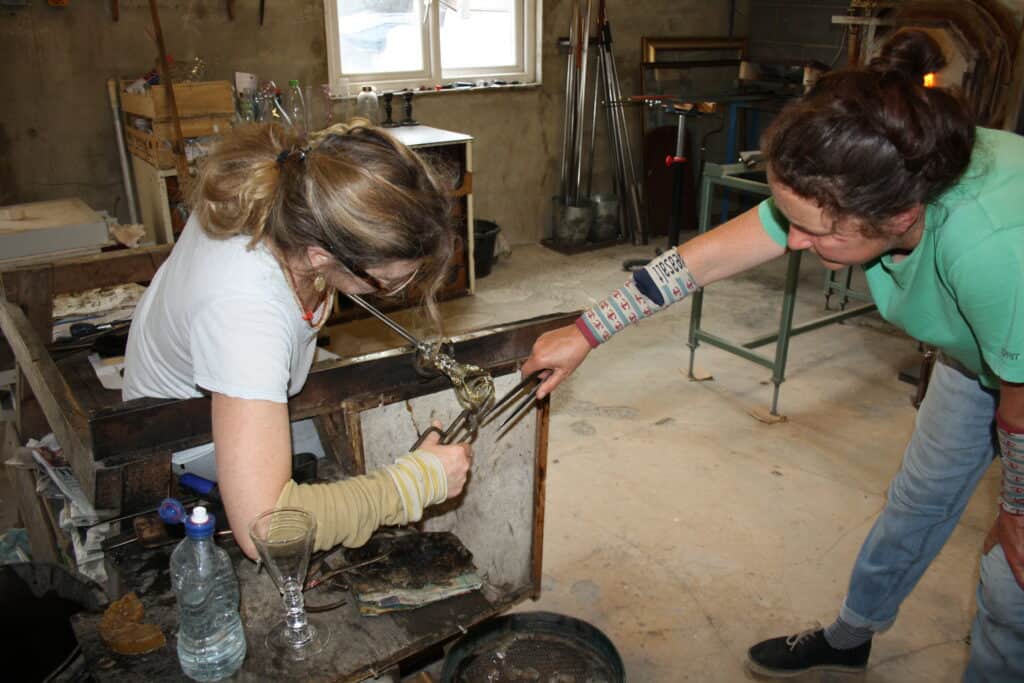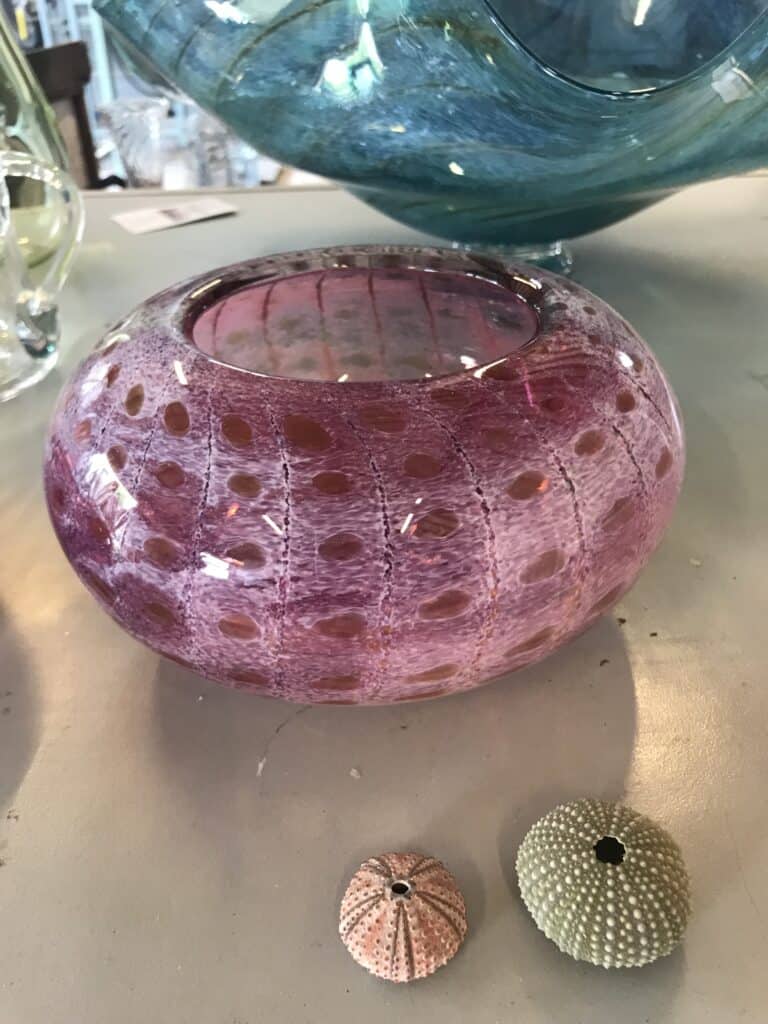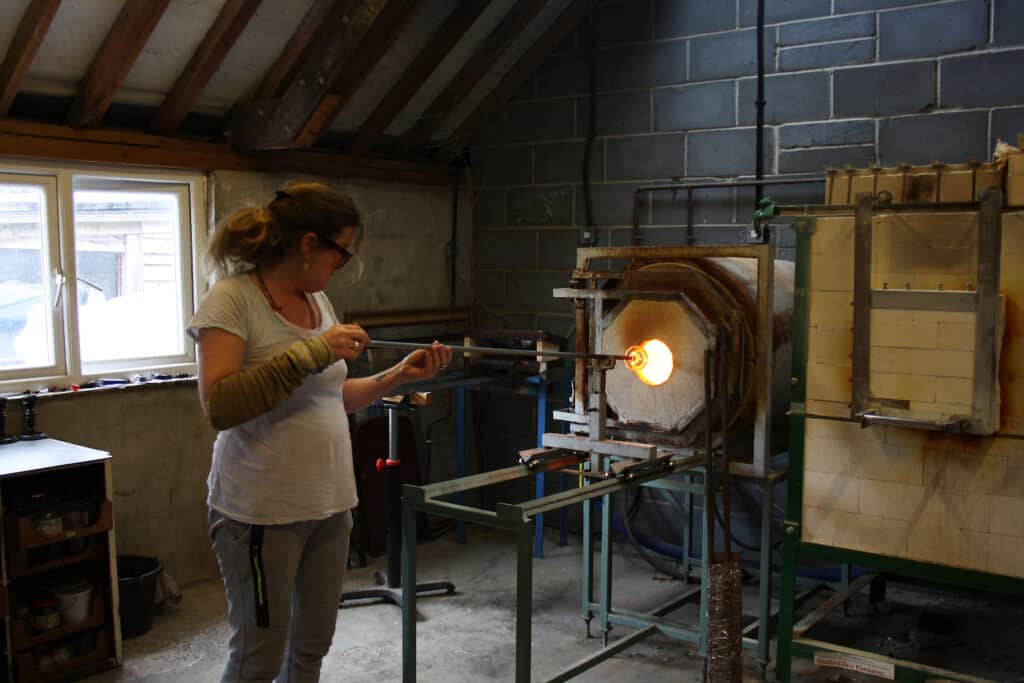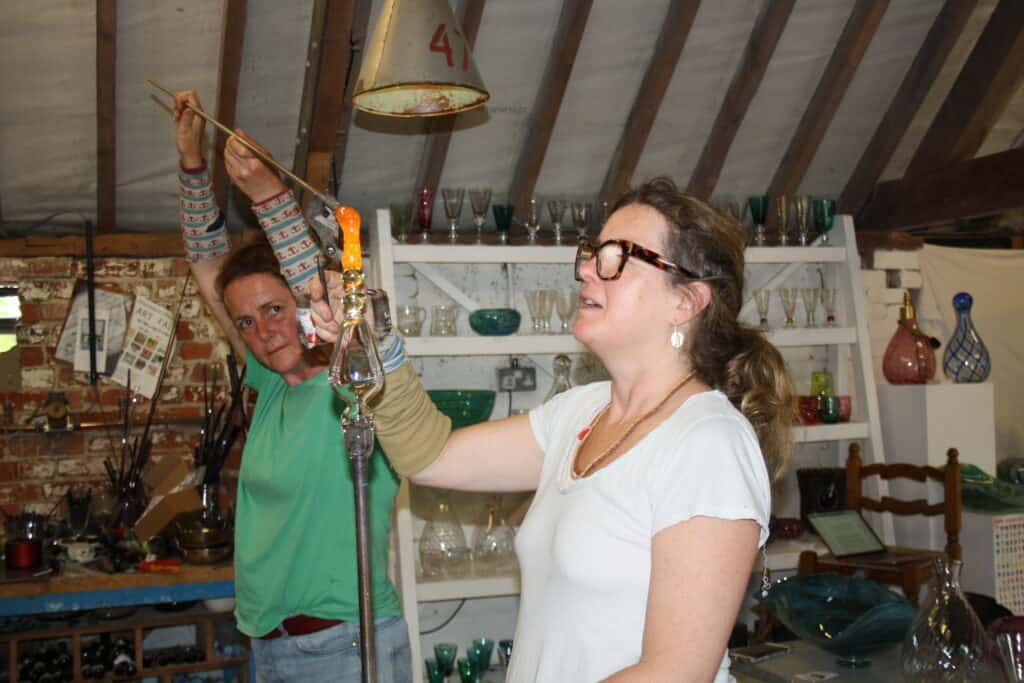The Venetian art of glassblowing is little changed in 800 years. Edwina Baines visited Emsie Sharp’s studio to interview the Murano-trained artisan

All images: Edwina Baines
At her studio in a converted cowshed at Gold Hill Farm, Child Okeford, Emsie Sharp pursues the art of glassblowing. Invented by Syrian craftsmen in first century BC, blown vessels for everyday use were produced and exported to all parts of the Roman Empire. By the Middle Ages, Venice had become a major centre for glass making – and, for fear of fire in the city, production moved to the island of Murano. Venetian glassmakers developed secret recipes and methods for making glass and at one time the craftsmen were not allowed to leave the island in the Venetian lagoon for fear their methods would be lost. Revealing their trade secrets was punishable by death.
Thankfully, no such rules apply now in Emsie’s studio! She was happy to demonstrate the techniques which have remained basically the same to the present day. Following a degree in glass from Farnham Art College, Emsie moved to London to work with both Adam Aaronson Designs and Columbia Glassworks. Three years later she left to work on Murano, the ‘Mecca of the glassblowing world’. The Maestro (or Gaffer) was the chief glassblower and Emsie was the only woman apprentice under his tutelage. Initially she spoke no Italian and had to learn Venetian (a separate language from Italian: “They use different words. It’s like learning English, then hearing Geordie!”).
Glassblowing takes years of practice and dedication to the Maestro, as well as specialised tools and equipment, and a Maestro’s two assistants were known as the servente and serventino. Emsie learnt her trade as the latter: “I would call it ‘the slave’!
“There were long days of tiring, repetitive work” said Emsie. “In Italy they are very traditional, very Venetian. They work on a high level of accuracy. Items have to match perfectly. But I don’t want all my pieces to be the same. In Murano the glass is made for show, something you would put on display in a cabinet. I want mine to be functional. Useful. I want people to feel the craft in each piece.”

It starts with cullet
Today, even on a cool morning, the studio is hot. Each piece starts life as molten glass in the furnace at around 1100ºC. With the price of gas rising all the time, keeping the furnace at this constant temperature is a considerable and increasing cost. The furnace is fed with 24 per cent lead crystal cullet (excess or broken crystal from the previous week’s production) purchased from Dartington Glass in Devon. “It’s a form of recycling” was how Emsie termed it.

I watched Emsie and her assistant Anne making several glasses which were part of a larger commission of wine glasses, decanters and candle holders. The molten glass is ‘gathered’ on the end of a hollow tube/blowing iron and inflated with a bubble. The vessel is shaped and formed by rolling on a smooth surface often consisting of pads of damp newspaper or an applewood block. The block is a wooden tool used to smooth and shape the molten glass into a spherical shape. The blocks are kept soaked in water before use, creating a layer of steam as the glass is shaped.
Emsie may also swing the iron and use gravity to make a longer shape if required. The stems and ‘spun’ foot are each attached separately, with Anne helping to apply a separate ‘fetch’ or bit of molten glass each time. A paddle is used to squeeze the foot between two apple wood boards so that it is even. A ‘punty’ or small metal rod is then attached to the bottom of the glass so that the other end can be fashioned. This leaves a small mark on the bottom of the glass which demonstrates that the item has been handmade.
Tools of the trade

Goldhill Organic Farm in Child Okeford
The tools of the glassblower are many and varied, each with specific names. Callipers are used to measure each glass for uniformity; a soffietta (a metal tube attached to a conical nozzle) is used to cool the glass before the next process. After the vessel has been removed from the blowpipe, the cone can be placed into the opening and used to further inflate it. Many of the tools originate from Venice; Emsie said hers “will last a lifetime.”
It was fascinating to watch the two women working together, in a seemingly effortless dance of adding, shaping, cutting and moulding.
Emsie also makes decanters, exciting sculptures and lamp bases. She says: “I don’t plan things out completely. I have an idea of the colours and shapes but I like the excitement of not knowing what’s going to happen. All the colours behave in different ways. In around 40 seconds, even though it’s still around 800ºC, the glass will cool down so much that you can’t work with it. The longer you let it cool, the longer it will take to heat back up.”

Cracks appear
The traditional process does not always go to plan and sometimes a crack appears when the article is removed from the rod. Often this can be removed when re-heated in a second furnace (called the ’glory hole’) where the rod is supported on a ‘yoke’ – but sometimes the glass shatters and all is lost. If all goes well, a final furnace or ‘annealer’ is used to cool the glass slowly, which keeps it from cracking. It was with a sense of satisfaction that I saw the beautiful finished article placed in the annealer and we all heaved a sigh of relief.
Emsie said: “I absolutely love what I do. Although it’s been a tough journey and I’m not going to be rich, I feel very privileged to be able to do it. I would like to pass on my knowledge to the next generation. There are technical skills which need to be taught.
“I want my work to be both useful and functional; I want people to feel the craft in each piece. The process is like alchemy – or an intricate dance.”
Hand-blown glass is generally thought to be more graceful than machine-made glass. This is preferable when drinking wine, not only for the way the glass balances in your hand – but because the glass enhances the wine, especially at the rim or lip. A thin, smooth edge where your lips meet the glass is best while taking a sip.
Seems like a good enough reason to keep this ancient art alive!

You can see Emsie’s work on www.sharpglass.co.uk – she is open for commissions, and has items for sale on her website.



